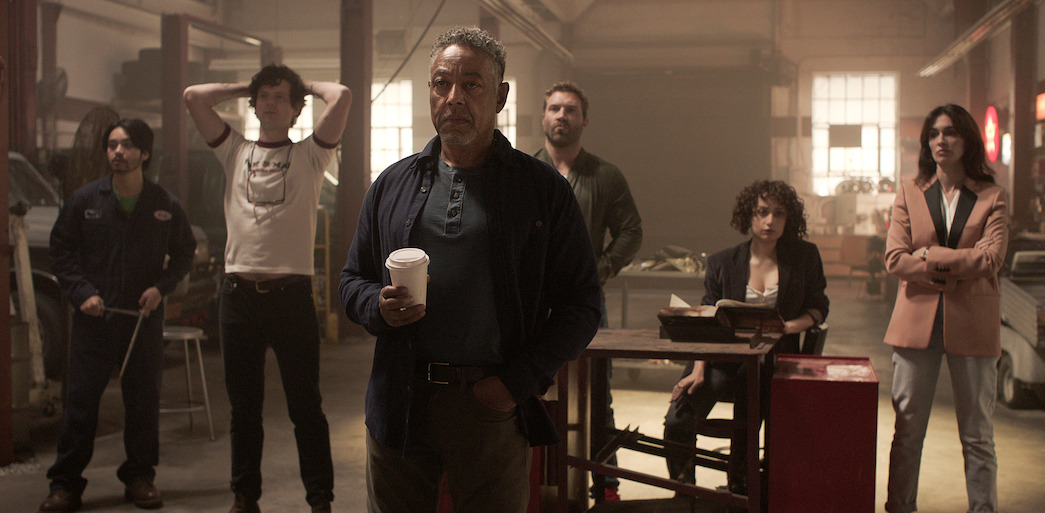Netflix’s new series ‘Kaleidoscope’ can be watched in over 40,000 ways.
Yes, you read that correctly. This new intriguing miniseries attempted to introduce a never-before-seen, revolutionary approach to interactive storytelling. But did it actually work? We tried to get to the bottom of that.
‘Kaleidoscope’ is an enthralling and intricate series that follows a crew of skillful crooks attempting to rob one of the world’s most powerful security firms in a heist secretly motivated by revenge.
Each of the eight episodes is named after a color in the rainbow, and takes place at a certain time before or after the heist—from 24 years before to six months after. According to the creators, they can be watched in absolutely any order. Whichever order they choose, viewers are immersed in the story as it barrels down towards the final showdown and the one episode that should always be seen last: the heist itself.
I came up with a bunch of different orders to watch Kaleidoscope in so you don’t have to pic.twitter.com/FE6IiwjzM9
— Netflix (@netflix) January 2, 2023
Created by American writer Eric Garcia, the series—which premiered on New Year’s Day—features a compelling cast of characters. The heist is conducted by a group of masterful thieves led by Ray Vernon (Giancarlo Eposito). The group of misfits he assembles include Ava Mercer (Paz Vega), Judy Goodiwn (Rosaline Elbay), Bob Goodwin (Jai Courtney), Stan Loomis (Peter Mark Kendall), and RJ Acosta Jr (Jordan Mendoza).
Upon clicking the show on their Netflix account, every user is given a distinct viewing order as a default. While some viewers might be plunged into the action three weeks before the heist, others may start at the chronological beginning, set 24 years before the heist.
Whatever the order is, ‘Kaleidoscope’ offers viewers the chance to link, connect, and combine the parts that make the story. In short, ‘Kaleidoscope’ does not offer the audience the clues on a silver platter—for better or for worse.
To bring our readers a proper review that takes into account Garcia’s unconventional storytelling decision, we—that is to say two members of the Egyptian Streets team—decided to watch it each in a different order from a list of combinations suggested by the official Netflix Twitter account. And for good measure, we consulted a friend who watched it in the default order presented to him automatically on Netflix.
Note: Stop reading here if you want to avoid spoilers. The below discusses key plot points of the series.
The story
Where to begin? To give a synopsis of a story, one has to have at least some grip of its chronology, and the chronology was different for each of us.
The ‘Usual Suspects’ order starts with the ‘Pink’ episode which picks up six months after the heist. This opening episode shows the audience the events that transpire after the heist; they only get to see the aftermath of an unknown story. The fate of the entire group is shown: they end up without the money, most are ultimately killed, and some run away. From there on out, the audience is left to piece together the story backwards.
Meanwhile the ‘Classic Detective Story’ order starts with the ‘Orange’ episode, which is set three weeks before the heist. An FBI agent is newly back at her job after recovering from addiction, when she discovers a connection between an armed robbery and the sketchy attorney who once informed her superiors of her drug problem. She decides to dig deeper, fearing a larger criminal operation may be underway.
Finally, the default order we encountered began with the episode ‘Yellow,’ set six weeks before the heist. In it, a group of misfits with a criminal history gather for the first time, to plan a robbery intended to fund a major heist that should ultimately yield billions of dollars. Cracks in the dynamic of the crew are quick to form, but having secured an ‘inside man’ (in this story a woman) for the big heist, they are not discouraged.
Crucially, two of these opening episodes fail to reveal one of the key elements of the story: the motivation for such a dangerous operation. Though undoubtedly the money may be considered motivation enough, for an audience to be captured by a heist story, there needs to be more.
And later it is revealed that the ringleader, Ray, who is terminally ill and the only one with access to the inside woman, has a 24-year-long grudge against Roger Salas, the owner of the security firm, who once left Ray’s wife to perish in a fire. Intent on revenge, Ray is the fuel for the operation.
The absence of this hook certainly took away from the story. Call us old-fashioned, but sometimes a predetermined chronology has a purpose in a story, and without it, it may not have as much punch.
Ultimately, the heist fails and the crew ends up with nothing, but with the help of the inside woman, Ray at least gets his revenge on Roger, who is revealed as a fraud and is framed for the attempted robbery.
The watching experience

For the claim that ‘Kaleidoscope’ can be watched in any order to check out, it seemed to us that the screenwriters had to oscillate dramatically between overly explicit expositions to make up for the possibility that a viewer was only just coming into the story, and episodes where there was so little context that the viewer had no way of knowing what was happening and what to pay attention to.
In the ‘Usual Suspects’ viewing order, the story begins at the chronological ending, leaving the viewer truly lost and unable to understand the events that transpire or the reasons for the fate of the characters. Meanwhile in the ‘Classic Detective Story’ viewing order, there is excessive exposition of the FBI agent, a character whose backstory barely comes into the core of the story at all.
We wonder why these structural mishaps can be found in the story–and if perhaps they would not be there if the structure was predetermined by the creators.
Not only that, but the storytelling technique resulted in the series being made up of a series of major plot points without buffers between them, leaving little space to give depth to the individual characters. As a result, we found little reason or motivation to feel strongly about many of them.
What, for example, makes Ava (Paz Vega), a successful, rich attorney with an undocumented loved one, take the risk of being a serial criminal? Or why does Judy (Rosaline Elbay), a brilliant, independent, and beautiful chemist, opt to marry Bob (Jai Courtney), a violent and macho man who knows little more than how to crack safes? There is not enough satisfying backstory to justify it.

The story was also riddled with small easter eggs for the attentive viewer. But we struggled to find the purpose in those of them we were able to find. One essential example of those is hidden in the episodes ‘White,’ (the heist) and ‘Pink,’ (six months after the heist).
At the very end of ‘Pink’, ringleader Ray Vernon, at this point attempting to live out the final days of his terminal illness free from his past, is shot dead by a hooded figure, whose only discernible and unique feature is a printed t-shirt. That same t-shirt is seen in the episode ‘White’, worn by the son of Roger Salas, who after the heist ends up with a hefty prison sentence.
While this little tidbit had the potential to be incredibly interesting, the extreme lack of background on Salas’ son made it almost meaningless once discovered. It almost felt as though it was an easter egg simply for the sake of an easter egg.
All of this is not to say that we did not enjoy the series at all. Our favorite parts of the watching experience were certainly the acting and the music.
For us, there were two standout acting performances. The first was Jai Courtney as Bob Goodwin, who–while an absolutely insufferable character–is portrayed with great skill. Courtney succeeds in combining a repulsive macho personality with an almost laughable air of satire, which appears to its best advantage in the episode ‘Pink’, where a throat injury renders him unable to speak, so he uses a mobile app to deliver his menacing threats–only to be interrupted by comical audio ads.
To our delight, Egyptian actress Rosaline Elbay also shone–and we are not only saying this out of bias. She has a compelling presence in every scene she appears in, even the ones in which her role is small. Her acting combines authenticity, humor, and charisma, and through every aspect of her acting, down to her facial expressions and body language, she became the character we all empathized with the most.
As for the music, the mild, jazzy, and bass-heavy score was well-suited for the heist theme, and the songs that played at significant plot points always fit like a glove.
Our takeaways
It is clear that the show is trying to combine the classic and beloved heist theme seen in modern classics such as ‘Oceans’ Eleven’ or the Spanish hit series ‘Money Heist’ (2017), with the newly emerging trend of giving the viewer some control over the storytelling, as can be seen in Netflix’s film ‘Black Mirror: Bandersnatch’ (2018).
But while ‘Money Heist’ focuses on telling an airtight story, and ‘Bandersnatch’ created a complete choose-your-own-adventure story, we found that ‘Kaleidoscope’ fell somewhere in between, and as a result got neither aspect well enough.
At the end of our viewing, the three of us seemed to be in agreement that in deciding on such an unconventional form of storytelling, Garcia got so caught up in the gimmick, that the story itself ended up taking a backseat. The theme of a heist is timeless, but to succeed it needs an edge, something that sets it apart from other heist films and series. And to us, a shuffled order was not enough to achieve that.
And while there was such a hype around the show and its unconventional and interactive style, it was unclear to us what purpose this style served, as ultimately we all got the same gist and felt similarly about the story.
If nothing else, the time jumps are distracting. There is a reason storytellers set their works in specific chronologies; it is a technique that helps their ideas come across and evokes emotional responses in viewers.
We do give the show the benefit of the doubt, though. It may be that we were so distracted by the back and forth of the story, trying to understand the purpose of the order in which events and plot points are revealed, that we were unable to fully enjoy the story or capture its essence or message.
But this in itself, we saw as a flaw, because the chronology of a story is not meant to confuse or distract, but rather to let the story unfold in a way that gives it a particular meaning. The shuffled nature of the show made its chronology at times feel arbitrary and accidental.
And so, we are left with a rather futile story: A heist motivated by revenge is foiled by the inside woman in a bid to protect the heist crew’s ringleader. The crew ends up with nothing, and four of its members end up dead. While the target of the heist is indeed destroyed to the pleasure of the vengeful ringleader, the ringleader himself is ultimately also murdered – presumably as revenge for the fate of the heist’s target.
So our question is: what was the point? What did any of the characters get out of this, and what are we, as viewers, meant to get out of it? There was no satisfying ending, no one to root for, and the ultimate foiling of the heist struck none of us as a clever twist.
As we sat in discussion, trying to comprehend the point this story was trying to make, the message it was trying to convey, we found ourselves coming up empty. Perhaps it is simply that crime doesn’t pay, and that a life spent hell-bent on revenge would amount to nothing. If this really is the message, then the unconventional storytelling style of Kaleidoscope is a rather contrived way to convey it.








Comments (0)